Bill Granger’s Australian food recipes
Quintessential Australian food chef Bill Granger shares some of his seasonal recipes exclusively with The Australian.

Sunshine is the one word that always comes to mind when describing Melbourne-born restaurateur and internationally bestselling cookbook author Bill Granger. From the buttercup hue of his famous cream-whipped scrambled eggs and the pineapple yellow of the shirts sported by his restaurant staff, to the brilliant suns-as-eyes illustration by Studio Frith on the front cover of his new cookbook Australian Food, there is always the feeling of summer in everything he does.
“When I think of Australia, it’s about the sun and the way it gives so much great energy,” Granger beams. “Whether it’s in the Outback or at the beach, Australia is always about great light and big skies, and those endless horizons where you feel close to sky and earth.” And it is this feeling he has captured in Australian Food, published 20 years after his first landmark cookbook Sydney Food (both Murdoch Books).
With an approach that is “more produce, less technique driven”, he suggests, the dishes he has been serving since opening the first Bill’s in Darlinghurst in 1993 – and which are now served across his 19 restaurants in Sydney, London, Tokyo, Honolulu and Seoul – have come to embody what the rest of the world now appreciates as the essence of Australian café culture.
“I have always believed Australia serves the sort of food that brings people together – over coffee, over communal tables, over all-day menus – and makes us all feel good,” he writes in the introduction to Australian Food. But most of all, “you can’t separate Australian food from the way we eat, which is in a really casual, easygoing way,” he adds when WISH meets him at the London home he shares with his wife, Natalie Elliott, and their daughters Edie, now 20, Inès, 18, and Bunny, 16, just days before the city returned unexpectedly to a second lockdown.
While Granger busily laid handpainted stripy terracotta plates – picked up from Christian Louboutin’s partner Rui Freitas’s Melides shop Vida Dura in Portugal – on top of dusky pink crushed linen table runners from Once Milano, the table’s centre decorated with pinecones, tangerines and bud vases of thistles and branches of red berries from favourite local florist Scarlet & Violet, he reflected on what exactly defines Australian food. “What’s different about it is that we’ve taken on foods from the many different cultures to arrive in Australia over the past 70 or so years,” he says.
This mash-up of influences has always been Granger’s style, too. “When I opened Bill’s in 1993, I was inspired by Italian cafés like Bar Coluzzi in Sydney’s King’s Cross,” he says. But rather than focus on serving European specialties, Granger wanted to apply the sweet, sour, salty, spicy zing of Asian dishes to the colourful array of Mediterranean ingredients. “I think that’s where the Australian food palate comes from now. We want that crunch, we want to taste every single part of a dish, we want those handfuls of fresh herbs to lighten everything up.”

Australian Food perfectly encapsulates this modern kaleidoscope of East meets West meets the Middle East meets Med flavours. Granger classics such as ricotta hotcakes, parmesan crumbed chicken schnitzel and poached eggs on smashed avocado toast now sit alongside poke bowls, curries, noodles and salads infused with kimchi, tahini, samphire, ponzu and yuzu, buckwheat, miso, pomegranate, turmeric, jalapeño chillies, freekeh and umeboshi plums.
For Christmas, the same ethos applies. “After years of giving my parents and grandparents a hard time for having hot roast dinners in 45-degree heat, in an ironic twist I’m going to be trying to bring some Australian sunshine to chilly, grey London,” Granger laughs.
This menu, prepared exclusively for WISH, is purposely “light and low key, with as little cooking as possible. Christmas is always about seafood for me,” Granger says of the cold-water oysters – “to get that great fresh taste of the sea” – and the lobsters he sources from the local one-stop food emporium, Notting Hill Fish + Meat, run by fellow Aussie Chris D’Sylva.
“When I was younger, Christmas was always about overeating and feeling heavy, but I don’t like that lethargic feeling anymore,” he says. So a light starter of crudité slivers of fennel, cucumber, baby carrots and watermelon radishes, served with a “really punchy” anchoïade-style dip, is followed by a freeform ricotta and tomato tart, barbecued lobsters drizzled with a Japanese-style dressing (infused with a hint of golden turmeric), and grilled vegetables.
A dessert of cherry semifreddo – “it’s easy – you don’t need an ice cream maker and it’s a nice way to finish” – is teamed with roast peaches and miniature meringues made by Inès, a whiz in the kitchen in her own right. “She’s a much better cook than me,” Granger readily admits.
This year will be one of only two festive seasons the family has spent in London after moving there in 2009. “Last year we thought, we won’t go back, we’ll stay here, and then five days before, I thought, we can’t do it, we have to go back home,’ Granger laughs. Having spent five months of the first lockdown in Australia – “it was that strange thing of wanting to get home, to feel safe” – this year they’re looking forward to a cosy English Christmas.
Granger’s dishes, as well as the light and breezy nature of his restaurants, are testament to what he calls the Australian “optimistic and multicultural” spirit. Certainly, this state of mind has helped him navigate the year’s challenges. “It has been a traumatic year for us all – I don’t think anyone’s escaped feeling moments of gloom and doom,” he says. “For myself, having the restaurants close for the first time in 28 years was so weird, because we never close except for Christmas Day. But there have been good things as well. It has been a year of appreciating what we do have and not what we’ve lost.”
bills.com.au
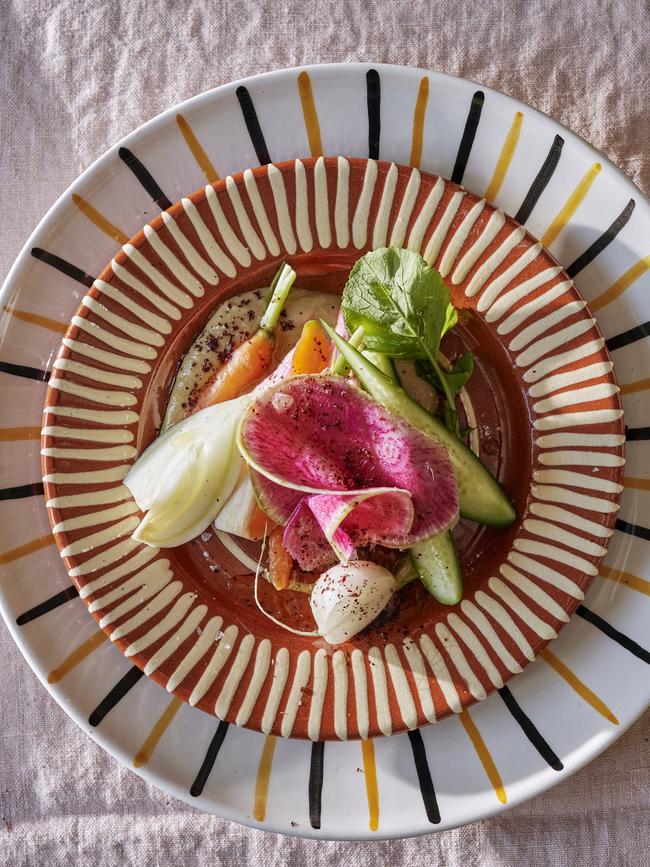
CRUDITÉS WITH ANCHOVY AND PARMESAN DIP
4 small cucumbers
1 fennel
1 bunch of radishes
2 watermelon radish (or candy beetroots)
2 bunches of baby carrots (or small carrots cut in half)
1 small bunch of basil
2 teaspoons extra virgin olive oil
Sea salt
Freshly ground black pepper
1 teaspoon sumac
Wash all the vegetables thoroughly. Cut the cucumbers and fennel into large shards, and slice the watermelon radish thinly (use a mandolin if you have one). Cut the breakfast radishes in half if they’re too large and keep some of the greens on a few of them. Toss the roughly chopped crudités in a teaspoon of olive oil and plenty of sea salt. To serve, spoon the anchovy dip onto the side of the plate, making a little indent to catch the oil and sumac. Place vegetables in a neat pile next to or on top the anchovy dip and sprinkle with a little sumac. Serves 6
Anchovy and parmesan dip
50g small tin of anchovies in olive oil (including the oil)
1 tbsp (30g) Dijon mustard
60ml olive oil
½ lemon, juiced (approx. 15ml)
20g finely grated parmesan
Place everything in a small jug and blend with a stick blender until thick, smooth and
emulsified. It should have the consistency of a loose mayonnaise. If it is slightly too thick add
a couple of drops of water. This recipe can easily be doubled to make more. Store in an
airtight container in the fridge. Makes 6 portions, lasts 3 days
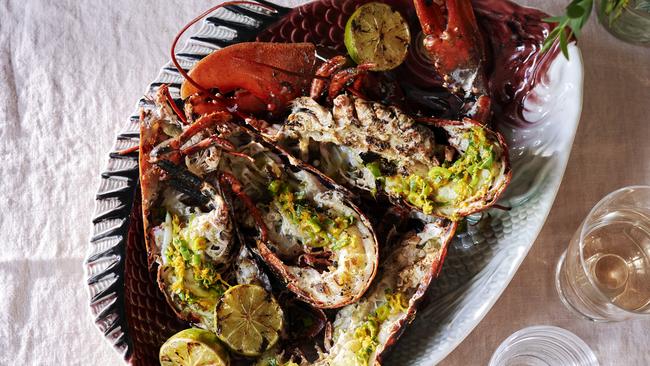
GRILLED LOBSTER, SPRING ONION AND TURMERIC RELISH
3 lobsters, halved and cleaned
3 limes, halved, griddled
Place the lobsters in the freezer for 15-20 minutes; this will stop the nerves and pain
receptors for when it’s dispatched. Put on a chopping board and place a very sharp large knife directly onto the groove of the head with the blade facing forward. Push the knife down in one firm movement and move it forward so the head is completely split in two. This will kill the lobster instantly. Turn the knife around and cut through the tail so that the lobster is completely split into two. It will continue to move a little but this is just the nerves reacting.
Clean out any of the green and black sacks left inside. Crack the claws all the way across with a sharp hit from the back of the knife. Oil and season well, and place directly on a hot griddle or barbecue. Cook for 6-8 minutes; the tail meat should easily pull away from the shell and the meat in the claws will steam inside the shells. Dress the meat with the spring onion and turmeric relish and squeeze the griddled lime over. Have an extra pot of sauce to dip the claw meat into. Serves 6
Spring onion and turmeric relish
75ml light-flavoured oil, such as grapeseed
4 spring onions, very finely sliced
20g knob of ginger, peeled and finely grated
5g knob of fresh turmeric, peeled and finely grated
1 small garlic clove, finely grated
Sea salt
Place spring onions in a heatproof bowl with finely grated peeled ginger, garlic and fresh
turmeric. Place the oil in a pan and heat until almost smoking. You can test a piece of spring
onion in the oil and it will start to fizz and bubble vigorously. Once it is hot enough, pour directly over the mixture and leave to cool. Once it is cooled, season to taste and use immediately.
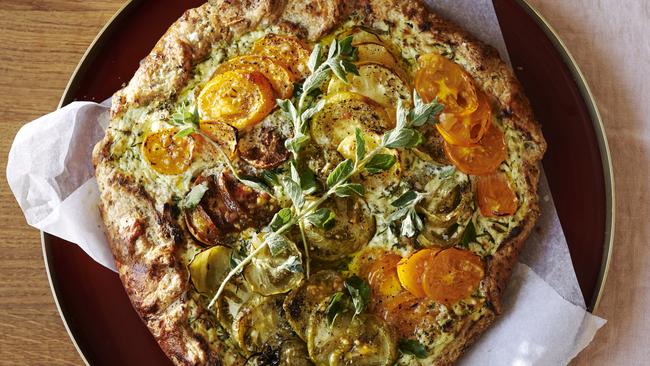
HERITAGE TOMATO AND RICOTTA TART IN RYE PASTRY
1 portion rough puff pastry
3 or 4 heritage tomatoes, sliced
500g ricotta
2 eggs, beaten
60ml double cream
100g finely grated parmesan
A pinch of nutmeg
1 small bunch rocket, finely shredded
1 small bunch basil, finely shredded
3-4 sprigs fresh oregano
Egg wash for glazing
Preheat an oven to 200C. Salt the tomatoes in a colander for 30 minutes to remove any
excess water. Roll out the pastry about 35cm in diameter so it’s about 3mm thick. Place on
a floured baking tray. Place the ricotta, eggs, parmesan and cream in a bowl and mix well. Season with plenty of black pepper and add the nutmeg. Fold in the basil and rocket, then place mixture in the middle of the dough leaving about 5cm around the edge. Fold the dough roughly over the filling, crimping the pastry as you go to keep the filling in. You want it too look rustic around the edges. Egg wash and rest in the fridge for 30 minutes (if possible), then cook for 35-40 minutes until golden brown. Leave to rest and garnish with fresh oregano.
Serves 6
Rough puff pastry
150g strong white flour
50g rye flour
½ tsp salt
200g chilled unsalted butter cut into chunks
2 tbsp chilled water
You can also use 100 per cent white flour, wholegrain flour or spelt flour for this recipe. Put the flour and salt in a bowl, add the butter and mix with your fingertips until the mixture is like rough breadcrumbs. Add cold water, cutting with a knife until it starts to form a ball. Wrap and cool in the fridge for 30 minutes. Roll the dough into a rectangle approximately 30cm x 15cm. fold the two short ends to meet in the middle then fold in again. Roll the pastry out to the same 30cm x 15cm again and repeat the process. Refrigerate for another 30 minutes before use.

GRILLED ZUCCHINI AND ASPARAGUS SALAD WITH SESAME AND BUCKWHEAT
300g raw buckwheat groats (can be mixed with quinoa or any other grain)
3 zucchinis, halved lengthways
1 bunch asparagus, woody ends trimmed
1 bunch spring onions, green ends removed
2 teaspoons extra virgin olive oil
100g shelled edamame (alternatively use peas, broad beans or a mixture of all), frozen are fine
1 small bunch shiso or perilla leaves
1 tbsp toasted sesame seeds (black, white or both)
Sea salt
Freshly ground black pepper
Bring the water to the boil and add the buckwheat. Cook for around 10-15 minutes
or until the buckwheat is softened but has a little bite. Drain and rinse with plenty of cold
water. Leave to drain. Meanwhile, toss vegetables in olive oil, season with salt and pepper and cook on a hot griddle pan or barbecue for around 5 minutes until nicely charred all over, and cooked. Set aside. Blanch the edamame in boiling water for a minute and refresh under cold water. Roughly chop the charred zucchini and toss in half the dressing with the rest of the
vegetables, beans and ripped shiso leaves. Season to taste. Mix the rest of the dressing
with the buckwheat and season. Spoon buckwheat onto a large serving dish then arrange the charred vegetables on top. Sprinkle with sesame seeds to finish. Serves 6
Ginger sesame dressing
30ml sesame oil
20ml olive oil
10ml ponzu
10ml mirin
Lemon (15ml) juiced
1 tsp grated ginger
1 tsp grated garlic
Place all the ingredients in a small bowl and whisk until combined. Alternatively, place in
a jar, seal and shake. This recipe can easily be doubled to make more dressing. Store in the fridge until needed. Makes 6 portions, lasts 1 week
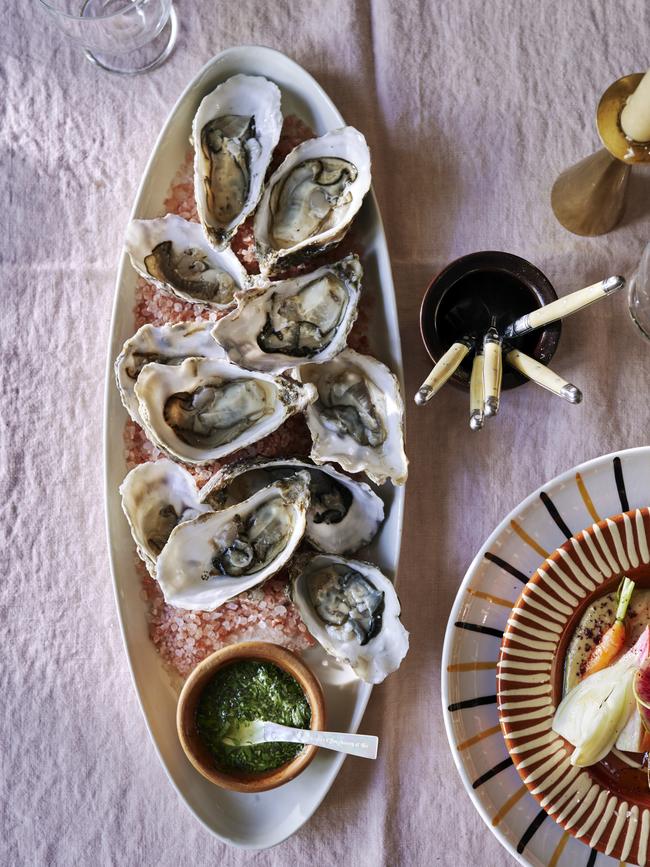
OYSTERS WITH GREEN CHILLI AND YUZU VINAIGRETTE
18 oysters, shucked and cleaned
Green chilli vinaigrette
If your fishmonger won’t open the oysters for you, be careful when opening. Place on a
board and hold firmly with a teatowel. Using only an oyster knife, push into the ‘hinge’ in the slim end of the oyster. Once you feel the shell start to release, move the knife gently around to make sure nothing gets stuck to the top of the shell. Once the shell has released give it a quick sniff to make sure it’s OK and gently cut through the muscle attaching the oyster to the shell. Try to keep as much water in there as possible. Place onto ice or rock salt to stabilise, and serve with a pot of vinaigrette in the middle and a wedge of lime for some extra acid.
Serves 6
Green chilli and yuzu vinaigrette
1 medium green chilli, deseeded
5g yuzukoshu
1 tbsp olive oil
50ml rice wine vinegar
1 tsp sugar
Small handful mint, picked (approx 5-10g)
Small handful coriander, picked (approx 5-10g)
Finely dice the green chilli, removing all the seeds, finely chop the mint and coriander, then
mix with the rest of the ingredients. If you can’t find yuzukoshu, use a teaspoon of yuzu
juice and a teaspoon of wasabi. It shouldn’t need seasoning as the oysters are salty, as
is the yuzukoshu. Serve immediately with your fresh oysters.
Makes 6 portions, use immediately
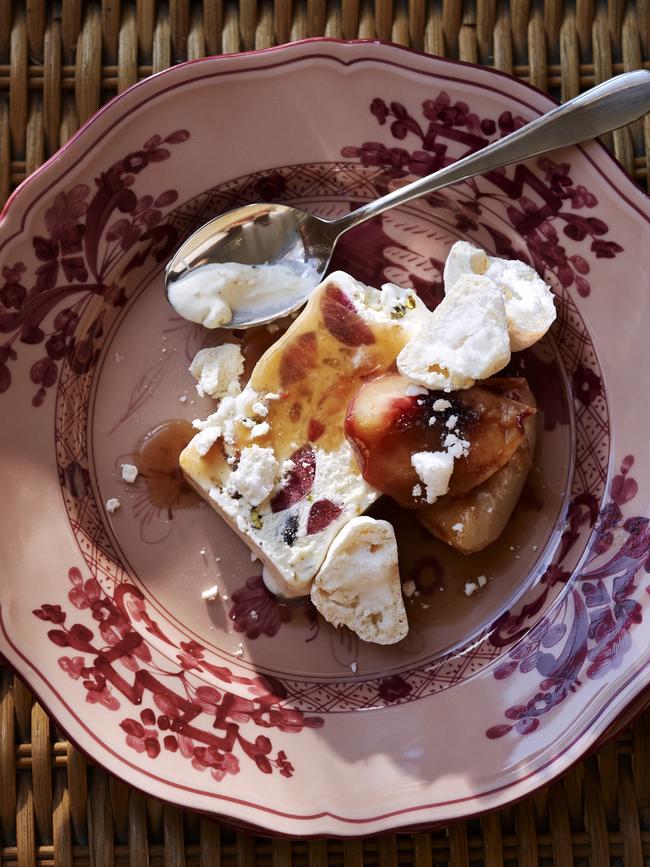
PISTACHIO SEMIFREDDO, VANILLA AND MAPLE ROAST PEACHES AND MERINGUE
380g can condensed milk
380ml double cream
1 vanilla pod
60g roasted crushed pistachios
100g pitted quartered cherries
De-seed the vanilla bean (retaining the skins to make vanilla sugar) and place in a bowl with the cream and condensed milk. Whisk everything together until you have stiff peaks. Halve the cherries and pull out the pips, then halve again. Roast the pistachios at 160C for 6-8 minutes and once cooled, lightly crush. Fold the pistachios and cherries through the mixture. Place in a 1 litre mould, smooth the top, cover and place in the freezer until set. Slice a thick piece of the semifreddo with a hot knife and place in a small dish. Place 3 peach quarters beside the semifreddo and drizzle with the syrup. Crumble the meringues on top for a little texture.
Makes 6 generous portions, lasts 2 weeks
Roast maple vanilla peaches
4 large white peaches
25g butter (about a tablespoon)
25g sugar (about a tablespoon)
1 lemon, juiced and zested
100ml maple syrup
1 vanilla pod
Quarter the peaches and remove stone. Remove vanilla pod seeds. In a large pan, heat the butter and sugar. Brown the peaches lightly then add the lemon, maple syrup and vanilla seeds. Bake in a preheated 180C oven for a further 10-15 minutes, depending on ripeness, and add a tablespoon of water if the mix is becoming too sticky. Cool and store in an airtight container in the fridge.
Makes 6 portions, lasts 2 days
Meringues
2 egg whites
100g caster sugar
The basic rule with meringues is double the amount of sugar to egg whites. If your egg whites are large and weigh 30g each, use 120g of sugar. Separate the whites from the yolks carefully – any yolk will stop the whites turning into meringue. In a very clean bowl, whisk whites until they start to froth and volumise. Slowly add the sugar as you continue whisking until mixture is thick, white and glossy and sits in stiff peaks. Pipe or spoon about 1 tablespoon mixture per meringue onto a non-stick sheet on a baking tray. Cook in a fanless oven at 100C for an hour to 90 minutes depending on whether you like a little chew. Leave to cool and set before using.

To join the conversation, please log in. Don't have an account? Register
Join the conversation, you are commenting as Logout